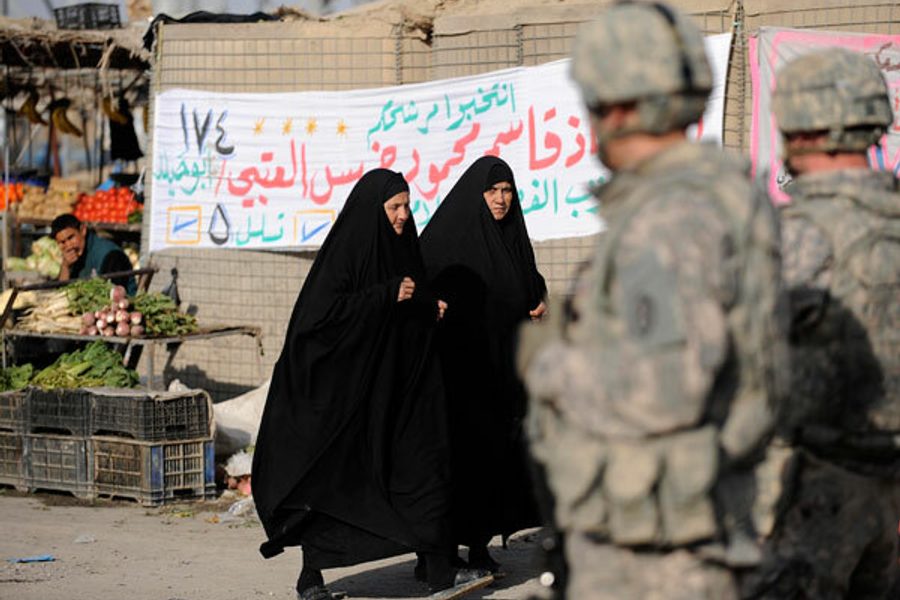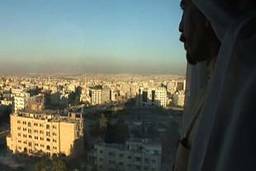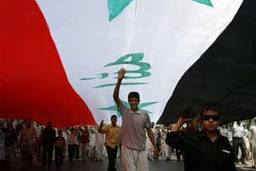
ABAA AL BOR, Iraq – At the height of sectarian fighting two years ago, Sunni militias fired hundreds of mortars each day on parts of this mostly Shiite village nine miles from Baghdad, driving nearly all of its estimated 50,000 residents outside Iraq or to other parts of the country.
“My house was destroyed and my son was kidnapped and killed,” says Abbas Fadhil, a Shiite imam who Sunni insurgents accused of being a militia leader. He left the city in 2006 and returned in 2007.
“There is reconciliation between the two sides,” Fadhil says, but reintegration has not taken place. “Shops and houses are still destroyed – more from the Shiites, but also from the Sunnis.”
On one street corner, I asked the half-dozen men standing there how many of them had lost an immediate relative – all claimed they had. Some raised shirts to show shrapnel wounds.
The United Nations recently estimated that as many as 500,000 of the approximately 2 million Iraqi refugees who fled the country might return this year. But they won’t necessarily be returning to the houses, neighborhoods or cities from which they fled. Many are simply returning because they can no longer afford to stay in neighboring countries, especially Syria, where Iraqis refugees struggle to obtain official work permits.
“The Americans provided no security, they did nothing for us,” says Hussein Fadhil, a Shiite and one of the estimated 2,000 people who remained throughout the fighting, despite the death of his father to a mortar. “They told us they didn’t know where the mortars were being fired from.”
In 2006 and 2007, staying in Sabaa al Bor was unthinkable for many who had once lived there. But today, at least half of the village’s population has come back.
Security has returned, thanks to the Sunnis’ realization that they had lost the civil war – a bitter pill to swallow. The Sunnis subsequently adopted the “Awakening movement” in late 2006, and it spread across the country in 2007.
Fearing expulsion from Baghdad, Sunnis formed security teams known as the “Sons of Iraq” and embraced the U.S. Army for patronage and protection from their Shiite rivals, whom they claim are supported by Iran.
Building walls
Iraq remains dangerous. During a two-week trip in mid-January, I still heard regular explosions. My reporting trips around Baghdad and its outskirts provided frequent evidence that, while violence has fallen to a comparative lull, attacks still occur.
On patrol with U.S. soldiers from the 1st Armored Division in Sadr City on Jan. 17, I was relieved that a bomb squad found and disarmed an “EFP” – an armor-piercing roadside bomb – before our patrol discovered it the hard way.
In the three weeks before I arrived, EFPs killed at least two U.S. troops in and near Sadr City, and soldiers discovered at least two others bombs before they exploded. The military has switched most of its vehicles to MRAPs (Mine Resistant Ambush Protected) – heavy vehicles nearly two stories tall that look absurd as they pass through normal traffic. Nevertheless, an EFP killed another soldier nearby the day after I went on patrol.
This sort of low-intensity violence could go on for years. The disarmed bomb, which the ordnance team said was homemade, had been wired for detonation with a cheap camera flash and 150 feet of copper wire. It had been buried in some garbage beneath a billboard depicting smiling Iraqis embracing members of the new Iraqi army.
According to author and former Marine Bing West, Iraq is the first vehicle-based insurgency. The U.S. military’s solution has been to build 100 miles of concrete walls and turn many Baghdad neighborhoods into easily controlled districts with one exit and entrance. The partitioning of more than half the city has also created sectarian enclaves in what were once mixed neighborhoods. It is unclear when most of the walls will come down, and for the moment more are being built than removed.
In Sadr City, one of the last neighborhoods in Baghdad to be walled off, U.S. Capt. Andrew Slack of the First Armored Division estimates his soldiers have built around three miles of walls in their sector, and continue to build them, though at a slower pace than before.
“We have not taken any down,” Slack says.
Many Baghdad residents say they are grateful for the walls. But others complain they are divisive, have damaged local economies, and make traffic nearly unbearable – trips of only a few miles can often take hours, and during rush hours hundreds of cars line up to enter and exit some neighborhoods. Emergency vehicles have trouble entering or leaving the neighborhoods, putting the lives of their residents at risk.
However Baghdadis feel about them, the walls remain a stopgap measure rather than a solution. In Sleikh, a northern Baghdad neighborhood that is mostly Sunni, local Sahwa commander Abu Waleed (not his real name), a former member of Saddam Hussein’s security forces who joined the Awakening movement, pointed to a closed bridge that separated his neighborhood from a nearby Iraqi and U.S. Army base. “They opened this 10 days ago,” he says. “Five days later, a bomb exploded, so they closed it again.”
Religious tensions
The Sons of Iraq might have helped decrease the violence in the short term, but decommissioning these paramilitaries will be difficult. According to Abu Waleed, the police and the army have incorporated between 5 and 10 percent of the Sons of Iraq, far fewer than the approximately 20 percent that the Iraqi government had promised.
He says that the members who have not been officially incorporated have not been paid.
“People are beginning to quit,” Abu Waleed says. “We demand that the Iraqi government pay attention to the Sons of Iraq, because they took part in securing the neighborhoods, and take care of those who quit their jobs.”
Meanwhile, in northern Iraq, the Kurds have once again been forced to accept the political and military status quo, at least until the United States fully withdraws. Continuous Turkish and Iranian shelling, and Turkey’s limited invasion in February 2008, though technically aimed at Kurdish insurgent groups, have sent a strong message.
Nonetheless, Kurdish leaders continue to posture. The campaign slogan of Iraqi President Jalal Talabani’s Patriotic Union of Kurdistan Party for January’s provincial elections – “a safety valve for the unity of Iraq” – sounded more like a veiled threat. Arab tribes in Kirkuk and Mosul continue to accuse Kurds of attempting to change the demographics of the region, whereas Kurds say that they are simply reversing the “Arabization” policies of Saddam Hussein. In Mosul, the country’s third largest city, car and suicide bombings remain facets of everyday life.
In the oil-rich Tamim province in north-central Iraq, of which the contested city of Kirkuk is the seat, provincial elections were not held because of tensions over whether the city should be part of the largely Kurdish autonomous region. Every attempt to legislate the issue or hold a referendum since the U.S. invasion in 2003 has been tabled. Tamim’s fate probably will not be settled without bloodshed.
So while an outbreak of violence in the north remains likely, Baghdad and the south continue to simmer as the government attempts to assert itself.
In July, when Ghani Abu Nabil, a Shiite, tried to return to his house in a mostly Sunni neighborhood in southern Baghdad, insurgents dragged him out on his front lawn and beat him while rigging his house with explosives and then destroying it. The message was clear: He was no longer welcome.
Standing in front of the destroyed house and with the U.S. soldiers at my back, I approached some of Abu Nabil’s former neighbors to ask what had happened. They watched the soldiers warily, then walked away.
Many Iraqis still blame the U.S. military for failing to respond following the destruction of the el-Askari Mosque, a sacred Shiite shrine in Samarra, north of Baghdad, in 2006. The raging violence that unfolded between Shiites and Sunnis leads many Iraqis to believe that encouraging civil war was part of a divide-and-conquer strategy, one that left Iraqis horrified, exhausted and more likely to accept the occupation as a safer alternative to civil war.
“They stayed on their bases for three days,” says Bashar Faidhy, a Sunni cleric in exile in Amman, Jordan.
The line of the U.S. military, however, is and has been that such matters are an Iraqi government responsibility, regardless of its capabilities or potential ulterior motives.
“Primarily, we like to see the Iraqi government support and help the Iraqi people,” said Lt. Gregory Ross, a member of the 2nd Brigade Combat Team in Sabaa al Bor.
Counting the dead
Despite the ongoing tension, changes in Baghdad are evident. For the first time since 2006, I felt comfortable taking a taxi and walking the streets. Smoking a narguila water pipe one evening at a café near our hotel – something I wouldn’t have considered three years ago – didn’t raise an eyebrow from any of the pedestrians. People were rarely seen out on the streets after dark in 2006; it’s now a common sight.
Public works projects by the Iraqi government, often supported by the U.S. military, were more evident than before, and the electricity supply had improved from just six months ago. Nevertheless, unemployment is still considerable, and the average Iraqi struggles to keep up with inflation. Malnourishment remains a serious issue. In 2007, Oxfam International estimated that 27 percent of Iraqi children are malnourished.
But at least a sense of security has returned. The current plan is for the Iraqi army to move out of Baghdad, ceding it to the police and Ministry of Interior commandos while the army begins to secure volatile areas outside the capital.
Amid the relative calm, the question must be asked whether Iraqi civilian deaths have been underreported. It’s unclear when, if ever, the full damage will be assessed. While estimates of the dead vary widely, many casualties have not been counted. My anecdotal evidence suggests that even the U.K.-based Iraq Body Count, the most widely cited study of Iraqi civilian casualties that tabulates deaths mentioned in the press and NGO reports, which puts the verifiable number at between 90,000 and 100,000, has underestimated the death toll.
Iraq Body Count doesn’t have any record, for example, of my friend Mehyar’s father, who, after being tortured, died of his wounds on an operating table in Damascus, Syria. Nor does it have a record of two Palestinians reported killed on March 26, 2007, while in police custody. Nor a Palestinian writer reportedly assassinated in his home 20 days before that.
There was no press report for the death of Jafar al Saidi, a lawyer I met who was killed in 2007 while trying to negotiate the release of another man from police in Baghdad. His burned body was returned to his family after they paid a ransom.
In 2007, the Iraqi government forbade journalists from photographing the scenes of explosions. I visited the site of a bombing in 2007, four days after a truck bomb had leveled an apartment building at dinnertime. After talking my way through the police cordon, I found families still digging bodies from the rubble with the aid of a backhoe. The Iraqi government said only 25 people were killed – a number I find impossibly low.
As early as 2005, it became clear that the Ministry of Health was downplaying the figures. In a country still unearthing mass graves from Saddam’s reign, a full account of what has taken place here may be a long time coming.
There is a cemetery on the edge of Sadr City that, as far as I know, has been photographed only once by the Western media. I have tried to find someone to take me there on my last two trips to Iraq, but it is in a potentially dangerous place. One could get robbed or, worse, draw attention to a secret someone wants hidden. No one even knows who its inhabitants are, and as far as I know, no one has tried to dig them up, even though the existence of the cemetery is an open secret in Baghdad.
Most Americans believe the end of the war is at hand, especially if President Obama is sincere about withdrawing all U.S. troops by 2011. But for Iraqis, its reckoning is far from over.







